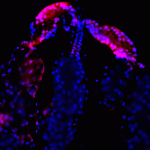Link to Pubmed [PMID] – 35147188
Link to DOI – fiac01610.1093/femsec/fiac016
FEMS Microbiol Ecol 2022 02; 98(1):
Mosquito larvae are naturally exposed to microbial communities present in a variety of larval development sites. Several earlier studies have highlighted that the larval habitat influences the composition of the larval bacterial microbiota. However, little information is available on their fungal microbiota, i.e. the mycobiota. In this study, we provide the first simultaneous characterization of the bacterial and fungal microbiota in field-collected Aedes aegypti larvae and their respective aquatic habitats. We evaluated whether the microbial communities associated with the breeding site may affect the composition of both the bacterial and fungal communities in Ae. aegypti larvae. Our results show a higher similarity in microbial community structure for both bacteria and fungi between larvae and the water in which larvae develop than between larvae from different breeding sites. This supports the hypothesis that larval habitat is a major factor driving microbial composition in mosquito larvae. Since the microbiota plays an important role in mosquito biology, unravelling the network of interactions that operate between bacteria and fungi is essential to better understand the functioning of the mosquito holobiont.

